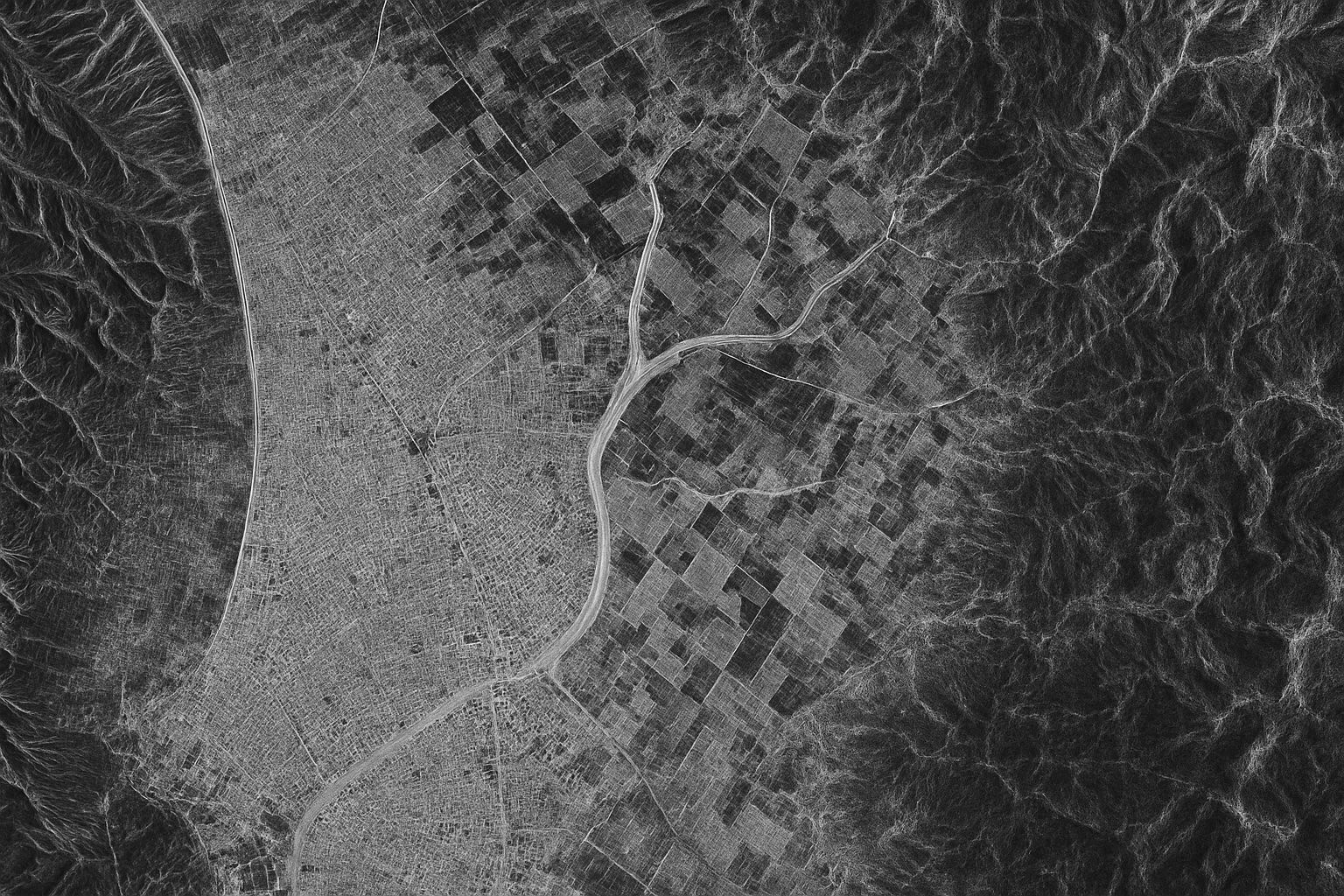- About 75% of the planet is obscured by cloud cover or darkness at any moment, making optical imaging inaccessible.
- Synthetic Aperture Radar (SAR) satellites actively illuminate the ground with microwave radar and synthesize a large aperture by moving the antenna to produce high-resolution images.
- SAR can operate day or night and in all weather, providing 24/7 imaging.
- Sentinel-1 (ESA) comprises satellites Sentinel-1A launched in 2014 and Sentinel-1B in 2016, with C-band SAR offering ~5 m resolution in high-resolution modes and 250–400 km swaths, and a 12-day revisit.
- RADARSAT-2 (Canada) launched in 2007, followed by the RADARSAT Constellation Mission (RCM) in 2019 with three satellites delivering daily coverage and up to ~3 m resolution (≈1 m in spotlight).
- TerraSAR-X (Germany) launched in 2007 and TanDEM-X in 2010 operated in close formation to produce an ultra-high resolution around 1 m and a global TanDEM-X elevation model at about 12 m detail.
- COSMO-SkyMed from Italy started with Gen 1 launches in 2007–2010 and Gen 2 in 2019–2020, delivering about 1 m resolution and up to 0.3 m in Spotlight mode.
- ICEYE launched the world’s first commercial SAR microsatellite in 2018; by 2023 they had 27 satellites, and in 2024 introduced a 25 cm “Dwell” imaging mode.
- Capella Space, founded in 2016, launched its first satellite in 2018 and by 2024 had around 10–15 satellites with resolutions as fine as 0.5 m (0.25 m on top products) and near-real-time delivery within minutes.
- NISAR, a NASA/ISRO joint mission planned for 2025, will carry dual L- and S-band SAR on a single 12-meter deployable mesh antenna, aiming to map the Earth’s land and ice every 12 days (effectively 6-day revisit).
Imagine peering down at Earth through thick clouds or the dead of night and still seeing clear images of the surface. Traditional optical satellites are blind in such conditions – in fact, at any given moment about 75% of the planet is obscured either by cloud cover or darkness, making it inaccessible to optical imaging [1]. Enter Synthetic Aperture Radar (SAR) imaging satellites – the ultimate “sky scanners” that illuminate the Earth with their own radar vision. SAR satellites are redefining Earth observation by providing 24/7, all-weather eyes on the planet [2]. From tracking storms through cloud cover to monitoring ground shifts in total darkness, SAR technology is unlocking insights impossible for ordinary cameras. In this report, we explore what SAR is and how it works, the advantages of radar imaging over traditional optics, and the myriad applications that benefit from SAR’s unique capabilities. We will also survey key SAR satellite missions (Sentinel-1, RADARSAT, ICEYE, Capella, NISAR, and more), highlight the major players driving SAR innovation, examine current trends like miniaturization and constellations, discuss the challenges of interpreting radar imagery, and peek into the future of SAR – including the rise of smallSAR constellations and AI-powered image analysis. By the end, it will be clear how SAR imaging satellites are truly redefining what it means to observe Earth.
Understanding Synthetic Aperture Radar (SAR)
Synthetic Aperture Radar is an advanced imaging technique that uses microwave radar signals to create high-resolution images of the Earth’s surface. Unlike an optical camera that passively captures reflected sunlight, a SAR system actively illuminates the ground with its own radio waves and listens for the echoes [3] [4]. SAR operates in the microwave portion of the electromagnetic spectrum (with wavelengths on the order of centimeters to meters), which allows its signals to penetrate clouds, rain, and haze that block visible light [5]. The basic idea is that as the satellite (or aircraft) carrying the radar moves forward, it sends out a series of radar pulses toward the ground and receives the reflected echoes. Through clever signal processing, these successive echoes are combined to simulate the effect of a much larger antenna – this is the “synthetic aperture” [6] [7]. In essence, the motion of the platform creates a very long virtual antenna, giving SAR its sharp vision. A larger antenna (real or synthetic) yields finer spatial resolution, so SAR achieves high resolution even with a relatively small physical antenna by synthesizing a large aperture from the platform’s movement [8].
In practice, a SAR satellite will transmit thousands of short radar pulses every second as it flies, and record the backscatter signals reflected from the ground features [9]. Each echo carries information about the strength of the reflection (related to the roughness and material of the target) and the time delay (which gives the distance, or range, to the target). By noting the slight Doppler shifts of echoes as the satellite moves, SAR can also discern fine differences in along-track position. Sophisticated algorithms then correlate and process all these echoes to construct a two-dimensional image of the scene [10]. The result is a radar image where bright spots indicate strong reflections (for example, buildings or metal objects that reflect strongly) and dark areas indicate weak reflections (calm water or smooth surfaces). Because SAR uses coherent radar (all pulses are in phase at a given frequency), the phase information can be retained for applications like interferometry (measuring ground deformation), but it also means the images have a grainy interference pattern called speckle – a unique characteristic of SAR imagery that we will discuss later.
In summary, SAR is a radar imaging technique that synthesizes a large antenna by moving a smaller antenna through space. It transmits microwave pulses and measures the echoes to produce detailed images of Earth’s surface. Because it supplies its own illumination and uses long-wavelength radar, SAR can operate day or night, in any weather, giving it extraordinary imaging capabilities that complement traditional optical satellite imagery [11]. These capabilities come with unique image characteristics (like speckle and lack of natural color), but also enable powerful applications from military reconnaissance to environmental monitoring.
Advantages of SAR Over Optical Imaging
SAR imaging satellites offer several distinct advantages over conventional optical Earth observation satellites. By using radar waves instead of visible light, SAR platforms can overcome many limitations that constrain optical imagers:
- All-Weather Imaging: SAR can see through clouds, fog, rain, and smoke with ease. Microwave radar penetrates cloud cover and is unaffected by smoke or haze, allowing SAR satellites to image the ground during hurricanes, wildfires, volcanic eruptions, and other events that would blind optical sensors [12] [13]. This all-weather capability is invaluable for disaster response and environmental monitoring when clear skies are rare.
- Day and Night Operation: Because SAR provides its own illumination via radio waves, it does not depend on sunlight. A SAR satellite images just as well at midnight as at noon. This 24/7 operability means critical observations aren’t missed due to Earth’s day-night cycle [14]. For example, a SAR constellation can monitor an area for changes multiple times overnight, something impossible with optical satellites limited to daylight passes.
- High Resolution and Detail: Modern SAR systems can achieve very high spatial resolutions (on the order of meters or even sub-meter). By synthesizing a large aperture and using advanced signal processing, SAR can distinguish fine details on the ground. Some X-band commercial SAR satellites now attain up to ~25 cm resolution [15], rivaling high-end optical imaging. This clarity is crucial for applications like urban mapping, infrastructure monitoring, and tactical surveillance [16]. Equally important, radar’s imaging geometry and wavelength give it a different sensitivity than optical – for instance, detecting subtle surface roughness or structural changes that a photo would not reveal.
- Penetration of Vegetation and Soil: Longer radar wavelengths (like L-band, ~23 cm) can penetrate through foliage, tree canopies, and even a shallow layer of dry soil [17]. This means SAR can expose ground features under forest cover or measure soil moisture and flooded terrain beneath crops. For example, L-band SAR can map the bare earth under a forest (useful for archaeology or geology) and detect how much water content is in the soil – capabilities beyond any optical sensor.
- Consistent Imaging Geometry & No Sun Glint: SAR sensors are typically side-looking and use consistent illumination angles, so they can maintain consistent imaging geometry across visits. They are also unaffected by lighting conditions like sun angle or glint (the mirror-like reflection of the sun off water) [18]. An optical image of a lake at certain angles might be washed out by glare, but a SAR image can always observe water surfaces (and even detect disturbances like oil slicks or ship wakes) regardless of sun position. This consistency and lack of glare make SAR data reliable for time-series analysis and maritime surveillance.
- High Revisit Rates: With SAR constellations, it’s possible to frequently revisit the same location multiple times a day. Since radar can operate in all conditions, scheduling imaging is very flexible. For example, ICEYE’s fleet of small SAR satellites can revisit some areas daily or even multiple times per day [19]. This high temporal resolution enables near real-time monitoring of dynamic events (flood progression, military movements, etc.) which would be difficult with a single large satellite. Even single SAR satellites often have wide swath modes (e.g. ScanSAR) to cover large areas frequently.
In short, SAR brings unparalleled resilience and flexibility to Earth observation: it’s essentially “weatherproof” and “nightvision-enabled” imaging with the ability to gather unique physical information (structure, moisture, roughness) that optical images cannot. These advantages make SAR a powerful complement to optical data, often filling critical gaps when optical imagery is unavailable or insufficient [20].
Major Applications of SAR
The unique capabilities of SAR have opened up a broad range of applications across industries and scientific disciplines. By delivering reliable imagery in conditions and ways optical sensors cannot, SAR has become an indispensable tool for:
- Disaster Monitoring and Crisis Response: SAR is a workhorse for mapping and responding to natural disasters. Radar satellites can quickly image affected areas through clouds and darkness, enabling rapid damage assessments. For example, SAR maps of flooded regions or hurricane impact zones help emergency agencies see which areas are underwater or devastated, even if thick clouds persist [21]. Radar’s sensitivity to surface changes means it can detect earthquake-induced ground deformation or landslides immediately. In disaster aftermath, SAR imagery guides rescue efforts by showing which roads or bridges are damaged and how water levels are changing.
- Agriculture and Forestry: In the agricultural sector, SAR provides vital information on crop and soil conditions. Radar can monitor soil moisture levels across fields – an important input for irrigation planning and drought assessment [22]. SAR is also used to map crop extent and growth stages; since microwaves bounce off plant structures, farmers can assess biomass and crop health. This helps optimize fertilizer use and identify pest or disease issues. In forestry, SAR can penetrate tree canopies to estimate timber volume and monitor deforestation or reforestation efforts. Unlike optical imagery, it can even observe forested areas during rainy seasons. All of this supports more precision agriculture and sustainable land management.
- Climate Science and Environmental Monitoring: SAR satellites are pivotal in tracking environmental changes on a global scale. They monitor glaciers and polar ice by penetrating cloud cover in the polar night, measuring ice sheet movements or sea ice extent with high accuracy [23]. Interferometric SAR (InSAR) techniques allow detection of ground subsidence or uplift of only a few millimeters, which is valuable for studying permafrost thaw, volcanic inflation, or groundwater depletion. SAR is also extensively used for forest monitoring (e.g., mapping deforestation in the Amazon under persistent cloud) and wetland mapping. By observing changes in radar backscatter, scientists can track land cover changes, forest biomass (important for carbon accounting), and even surface water extent. These contributions are crucial for climate change research and environmental protection.
- Military Surveillance and Intelligence: From its early origins, SAR has been a key asset for defense and intelligence agencies. The military values SAR for all-weather reconnaissance – radar satellites can spot vehicles, ships, aircraft on the ground, or infrastructure targets regardless of camouflage by clouds or darkness [24]. High-resolution SAR images can reveal installations or changes (e.g., new structures or movements in a base) that optical may miss due to weather. Moreover, SAR can sometimes detect targets invisible to optical: for instance, stealth aircraft might be designed to evade radar, but SAR imagery can still detect disturbances like tire tracks or wake patterns. SAR also supports maritime domain awareness by tracking ships at sea (even when they try to hide under clouds or at night) and detecting illicit activities. In summary, SAR provides persistent surveillance capability for defense and national security, complementing optical spy satellites.
- Infrastructure and Urban Planning: In urban areas, SAR is used to monitor infrastructure stability and ground deformation. By comparing phase information of radar images over time (InSAR), engineers can detect subtle movements of structures or terrain – for example, millimeter-scale subsidence of a bridge, building, or dam, long before a collapse happens. City planners and scientists use SAR to identify land subsidence in megacities (due to groundwater extraction) or to map how infrastructure holds up after an earthquake. SAR can also aid in urban growth mapping: its ability to operate at night allows frequent imaging of construction progress and city expansion [25]. Because radar can detect differences in building materials and structure, it can differentiate urban vs. vegetated land and even help classify types of structures when combined with advanced analysis. These insights support safer infrastructure management and smart urban development.
- Maritime and Ocean Monitoring: Over the oceans, SAR plays a crucial role in monitoring sea state, sea ice, and human activities. Radar images can map oil spills or pollutant slicks on the water surface by detecting changes in wave roughness [26]. SAR is also excellent at measuring wave heights and ocean surface winds (useful for weather forecasting and ship routing) by observing the wave patterns imprinted on the sea surface. For maritime security, SAR constellations allow near-real-time ship detection and tracking, even for vessels that may not broadcast their location. This helps combat illegal fishing, piracy, and smuggling. In polar regions, SAR monitors sea ice extent and leads (gaps in ice), guiding icebreaker ships and providing data for climate studies. Coastal managers rely on SAR to track shoreline changes, coastal erosion, and even mapping of flooding in coastal cities during storm surges [27]. Simply put, SAR extends our vision to the oceans and ice-covered areas where optical methods are often ineffective.
These examples only scratch the surface – SAR’s applications are numerous wherever persistent, reliable imaging or unique measurement capabilities are needed [28] [29]. From archaeology (finding buried structures under desert sand or jungle canopy) to topographic mapping (the Shuttle Radar Topography Mission produced a near-global elevation model), SAR has proven to be a game-changer in remote sensing. Its ability to consistently monitor Earth’s processes in 2D and even 3D (through interferometry and tomographic SAR) makes it an essential tool for understanding and managing our world.
Key SAR Satellite Missions and Programs
Over the past few decades, a variety of SAR satellite missions – run by space agencies and increasingly by commercial companies – have been launched to exploit these capabilities. Here we highlight some of the most important SAR missions and constellations, along with their characteristics and contributions:
- Sentinel-1 (ESA/EU): Part of Europe’s Copernicus program, Sentinel-1 consists of twin satellites (1A launched in 2014, 1B in 2016, with replacements 1C and 1D in development) carrying C-band SAR imagers. They operate in a sun-synchronous orbit with a 12-day repeat (6-day combined) [30]. Sentinel-1 provides free and open SAR data to the world [31], supporting countless applications in environmental monitoring, ice tracking, marine surveillance, and disaster mapping. The C-band radar on Sentinel-1 offers a spatial resolution down to ~5 meters in its high-resolution modes [32] and can map swaths up to 250–400 km wide. This combination of decent resolution and wide coverage, plus the reliability of a multi-satellite constellation, has made Sentinel-1 a workhorse for scientists and governments globally. Notably, Sentinel-1 data underpins global InSAR ground motion maps and rapid flood mapping services for emergency response.
- RADARSAT Series (Canada): Canada has been a pioneer in civilian radar observation. RADARSAT-1 (launched 1995) and RADARSAT-2 (2007) were large C-band SAR satellites emphasizing maritime surveillance (e.g., sea ice monitoring for shipping) and resource management. RADARSAT-2 introduced advanced beam modes with up to 3 m resolution imaging and flexible polarization options [33]. In 2019, the RADARSAT Constellation Mission (RCM) was deployed, consisting of three smaller C-band satellites working together to provide daily re-visits over Canada’s vast territory and the Arctic. RCM offers high-resolution modes (~3 m and a specialized spotlight mode around 1 m) similar to Radarsat-2 but with more frequent coverage, greatly improving monitoring of ice, oceans, forests and security for Canada [34] [35]. The RADARSAT program has been instrumental in demonstrating SAR’s value for government applications and continues to provide critical all-weather data for a variety of users.
- TerraSAR-X / TanDEM-X (Germany) and PAZ (Spain): Germany’s TerraSAR-X (launched 2007) and its twin TanDEM-X (2010) are X-band SAR satellites that have achieved very high resolution (~1 m and below) imaging. They flew in a close formation to act as a single pass interferometer for generating an ultra-precise global 3D elevation map. This TanDEM-X mission mapped Earth’s terrain in 12-m detail, showcasing the power of SAR interferometry. Spain’s PAZ satellite (2018) is essentially a clone of TerraSAR-X (built with Airbus Defence and Space) and shares the same orbital plane, increasing revisit frequency. These missions, operated partially commercially by Airbus, have provided high-quality data for both scientific and military customers [36] [37]. TerraSAR-X and PAZ demonstrate European capabilities in high-res SAR and have been used in everything from urban mapping to monitoring conflict zones.
- COSMO-SkyMed (Italy): Italy’s COSMO-SkyMed is a constellation of X-band SAR satellites funded by both civil and defense agencies. The first generation (4 satellites launched 2007–2010) provided up to 1 m resolution imagery with rapid revisit, focused on Mediterranean region security, disaster management, and scientific use. A second generation began with two new satellites launched in 2019 and 2020, featuring improved capabilities (spotlight modes well under 1 m, reportedly ~0.3 m resolution in Spotlight-2 mode) [38]. COSMO-SkyMed has been a valuable asset for near-real-time tactical surveillance and emergency response in Europe, and it often works in concert with other systems (e.g., sharing data with France’s optical satellites) to provide a complete situational picture.
- ALOS PALSAR (Japan): The Japan Aerospace Exploration Agency (JAXA) has flown L-band SAR on its Advanced Land Observing Satellites. ALOS-1 (“Daichi”, 2006–2011) carried the PALSAR L-band radar which achieved ~10 m resolution and was used extensively for forest and disaster mapping in Asia. ALOS-2 (2014, still operational) upgraded this to PALSAR-2 with higher resolution modes (down to 3 m, and a spotlight mode ~1×3 m) [39] [40], and has been crucial for continuous forest monitoring, landslide detection, and mapping tectonic deformation in Japan and worldwide. ALOS-4 is planned to continue this legacy. The L-band data from PALSAR is particularly prized for biomass estimation and deforestation tracking (it was used to generate global forest maps), showcasing a different frequency’s advantages.
- Gaofen-3 and Other Chinese SAR Satellites: China has rapidly expanded its SAR satellite portfolio in recent years. Gaofen-3 (first launched 2016, followed by GF-3 02 in 2021) are C-band SAR satellites providing sub-meter resolution and multi-polarization imaging for marine monitoring and disaster mitigation. China’s commercial sector has also entered the SAR arena: e.g., Hisea-1 (X-band SAR microsatellite, 2020) was China’s first small commercial SAR, and more startups are launching constellations [41] [42]. This mirrors the global trend of miniaturization. Chinese SAR data is used for ocean surveillance, crop monitoring, and military reconnaissance, among other things, reflecting a broad adoption of the technology.
- ICEYE Constellation (Finland): ICEYE, a Finnish company, made headlines by launching the world’s first commercial SAR microsatellite in 2018. Since then, ICEYE has deployed a large constellation of small SAR satellites (each roughly 100 kg). As of mid-2023, they had successfully launched 27 SAR satellites – the largest SAR constellation in operation [43] – and they continue to launch more. ICEYE satellites use X-band radar and initially offered 3 m resolution imagery, but the company has rapidly innovated to improve resolution. In 2024, ICEYE introduced a new “Dwell” imaging mode that achieves 25 cm resolution – the highest currently available from a commercial SAR service [44]. These satellites are much cheaper and faster to build than traditional SAR platforms, proving that miniaturized SAR can deliver high-quality data. The ICEYE constellation’s ability to revisit sites frequently (many satellites sharing the task) has enabled monitoring of fast-changing phenomena like floods and ground sinking with unprecedented timeliness. ICEYE works with clients in insurance, government, and logistics, delivering on-demand imagery day or night. This paradigm shift – from one-off big satellites to agile constellations – is a major aspect of SAR’s renaissance in the 2020s.
- Capella Space (USA): Capella Space is an American startup that also spearheaded the small-SAR revolution. Founded in 2016, Capella launched its first satellite in 2018 and a series of next-generation “Whitney” satellites through 2020–2022, followed by new “Acadia” satellites in 2023. By 2024, Capella’s constellation had grown to around 10–15 satellites, with plans for many more. Capella’s X-band SAR produces very high-resolution imagery (down to 0.5 m, and even 0.25 m for its highest-quality products) [45], making it competitive with the best optical systems in detail (while of course offering the all-weather, day/night benefits of radar). The company has focused on a platform for on-demand tasking and rapid delivery – users can request a radar image of a location via a web portal/API, and thanks to Capella’s network of ground stations and even inter-satellite links through geostationary relays [46], they can receive the processed image in as little as minutes after collection. Capella was the first U.S. company to launch a commercial SAR satellite [47], breaking ground for what is now a vibrant U.S. industry. Its data is used in applications from monitoring illegal maritime activities to tipping & cueing high-resolution optical satellites when something changes on the ground.
- NISAR (NASA/ISRO): Slated for launch in 2025, the NASA-ISRO Synthetic Aperture Radar (NISAR) will be one of the most advanced civil SAR satellites ever. This joint mission between the U.S. and India is the first to operate dual frequencies (L-band and S-band) simultaneously on one platform [48] [49]. NISAR carries a huge 12-meter deployable mesh antenna – the largest ever for a radar satellite – to allow wide swath coverage and strong signals [50] [51]. It will map the entire Earth’s land and ice surfaces every 12 days (with an effective 6-day revisit for most areas) and aims to systematically measure changes in ecosystems, ice sheets, glaciers, and geological processes [52]. NISAR’s data (which will be open and free) will support applications like forest biomass estimation, crop monitoring, landslide and earthquake deformation mapping, and even groundwater monitoring through subtle surface movement [53]. With its dual-band design, NISAR can capture both the tree canopy (via S-band, ~10 cm wavelength) and trunks/ground (L-band ~24 cm) for forests, or measure different aspects of soil and snow. Its expected imaging resolution is on the order of 3–10 m depending on the mode [54]. NISAR exemplifies a state-of-the-art scientific SAR mission, emphasizing data quality, calibration, and global coverage. It is also noteworthy for the international collaboration and technology exchange (NASA providing the L-band SAR, ISRO the S-band SAR and satellite bus).
These missions are just a representative sample of SAR programs that have redefined Earth observation. Other notable mentions include the Shuttle imaging radar missions (NASA’s SIR-A/B/C in the 1980s–90s, which first demonstrated spaceborne SAR imaging and even multi-frequency SAR with SIR-C/X-SAR [55]), and emerging commercial players like Umbra (USA) and Synspective (Japan) deploying their own small SAR satellites. Table 1 below provides a comparison of several major SAR satellites and their capabilities:
Table 1: Comparison of Selected SAR Imaging Satellite Missions
| Satellite / Mission | Operator | Radar Band | Resolution (approx) | Launch | Notable Features |
|---|---|---|---|---|---|
| Sentinel-1A/B (EU) | ESA / EU (Copernicus) | C-band (5.4 GHz) | ~5 m (high-res mode) [56] | 2014, 2016 (1C: 2024) | Free open data; 250 km swath; 6-day revisit (2 sats) [57]. Global environmental and crisis monitoring. |
| RADARSAT-2 (Canada) | CSA / MDA (public-private) | C-band (5.4 GHz) | ~3 m (Spotlight ~1–3 m) [58] [59] | 2007 | Flexible polarization (quad-pol); used for marine surveillance, ice mapping, disasters. Follow-on RCM (2019) has 3-sat constellation for daily coverage. |
| TerraSAR-X (Germany) | DLR / Airbus DS | X-band (9.6 GHz) | ~1 m (Spotlight <1 m) | 2007 | Very high resolution; formed TanDEM-X pair for 3D mapping. Commercial data via Airbus; succeeded by TerraSAR Next plans. |
| COSMO-SkyMed (Italy) | ASI / Italian MoD | X-band (9.6 GHz) | ~1 m (0.3 m in 2nd Gen Spotlight) [60] | 2007–2010 (1st Gen); 2019–2020 (2nd Gen) | 4-satellite constellation (first gen) for dual-use (civil/military); fast revisit; second generation improving resolution and capacity. |
| ALOS-2 (Daichi-2) (Japan) | JAXA | L-band (1.2 GHz) | ~3–10 m (Spotlight ~1×3 m) [61] | 2014 | Long wavelength L-band penetrates forests; focus on Asia-Pacific disaster and forest monitoring. InSAR for tectonics. Successor to ALOS-1 (2006). |
| Gaofen-3 (China) | CNSA (China) | C-band (5.4 GHz) | ~1 m (Spotlight) | 2016 (GF-3-01); 2021 (GF-3-02) | First Chinese civilian SAR; multi-polarization modes; supports marine surveillance and disaster monitoring. Part of China’s CHEOS program. |
| ICEYE Constellation (Finland) | ICEYE (private) | X-band (9.7 GHz) | 1 m (Spotlight <0.5 m; new mode 0.25 m) [62] | 2018–present (27 launched by 2023) [63] | Dozens of ~100-kg microsatellites – world’s largest SAR constellation. Offers very frequent revisits (sub-daily) and high-res imaging. Pioneered smallSAR tech, 25 cm “Dwell” imaging [64]. |
| Capella (USA) | Capella Space (private) | X-band (9.5 GHz) | ~0.5 m (best ~0.25 m) [65] | 2018–present (15+ sats by 2024) | U.S. commercial constellation focusing on on-demand high-resolution tasking. 3.5 m deployable antenna per satellite; real-time tasking via Inmarsat link [66]. Targets defense, intelligence, and commercial markets. |
| NISAR (USA/India) | NASA / ISRO (joint) | L-band & S-band | ~3–10 m [67] | 2025 (planned) | Dual-band SAR on one platform – first of its kind. 12 m deployable mesh antenna [68]; 12-day global coverage (open data) [69]. Focus on science: ecosystems, hazards, climate change monitoring. |
Sources: Key specifications compiled from mission documentation and literature [70] [71] [72] [73] [74] [75].
As shown above, SAR missions span a range from large government-funded satellites to agile new-space constellations. The operators include national space agencies like the European Space Agency (Sentinel-1), Canadian Space Agency (RADARSAT), German DLR (TerraSAR-X), Italian Space Agency (COSMO-SkyMed), JAXA (ALOS series), NASA/ISRO (NISAR), CNSA (Gaofen), and others, as well as private companies like ICEYE, Capella Space, Airbus Defence & Space, MDA, and emerging startups. In recent years, the commercialization of SAR technology has greatly expanded – private companies are launching their own SAR fleets to serve both government and commercial clients [76]. Capella Space’s trailblazing U.S. SAR satellite was followed by ICEYE’s rapid constellation growth, marking a shift from SAR being the domain of a few large agencies to a more diverse ecosystem. Notably, Capella was the first U.S. commercial SAR operator and continues to innovate with higher resolution and faster revisit offerings [77]. Meanwhile, Airbus operates the TerraSAR-X/TanDEM-X and PAZ missions, providing data commercially around the world [78]. This blend of governmental and commercial efforts has led to a golden age of SAR data availability. Users today can tap into free public datasets (like Sentinel-1 or soon NISAR) or purchase high-resolution imagery from multiple vendors, depending on their needs. The competition and collaboration among these players are driving SAR capabilities to new heights.
Current Trends and Innovations in SAR Technology
The field of SAR satellite observation is rapidly evolving, spurred by technological innovation and the changing demands of the market. Some of the key trends and recent innovations in SAR technology include:
- Miniaturization and Constellations: Perhaps the most revolutionary change is the shift from a few heavy satellites to many smaller satellites working in unison. Historically, high-performance SAR systems required satellites weighing on the order of 1,000 kg and costing hundreds of millions of dollars [79]. This limited SAR to superpowers and large agencies. Today, thanks to advances in electronics, antenna design, and computing, companies like ICEYE and Capella have proven that a capable SAR can be packed into a microsatellite under 150 kg. This miniaturization has massively reduced build and launch costs, enabling constellations of SAR satellites. More satellites mean more frequent revisits and the ability to monitor multiple targets simultaneously. For example, ICEYE’s approach of many agile SAR microsats allows imaging of the same location several times per day [80], a feat a single large satellite could never achieve. Capella Space likewise emphasizes deploying numerous satellites into diverse orbits for global coverage. This trend parallels what happened with optical Earth imaging, but it was slower to come to SAR due to the greater technical challenges (power, antenna size, data processing). Now that it’s here, we’re seeing a boom in SAR constellations worldwide – essentially a SAR satellite boom driven by smaller, cheaper platforms [81].
- Higher Resolution & New Radar Techniques: Continuous improvements in hardware are pushing the limits of SAR image resolution. One innovation is the use of wider bandwidth radar signals and advanced signal processing to sharpen image detail. For instance, ICEYE recently demonstrated a 1200 MHz bandwidth system (in X-band) to achieve 25 cm resolution imagery on a small satellite [82]. Commercial providers are racing toward the ~20–30 cm class, which was once exclusive to the most secret military radar satellites. On the public side, Italy’s second-gen COSMO-SkyMed and Germany’s upcoming SAR missions also feature sub-meter resolution capabilities. Another technique boosting resolution and coverage is digital beamforming – using multi-channel antenna feeds and phase control to form multiple beams or steer beams electronically. This can allow a satellite to cover wider swaths or simultaneously image multiple areas with high resolution. Research missions like Germany’s Tandem-L concept propose using multiple transmit/receive channels and even multiple satellites in formation (a bit like a flying array) to achieve both high resolution and wide coverage. These innovations point to future SAR systems that break the traditional trade-off between swath width and detail, giving us “both” instead of “either/or.”
- Polarimetry and Multi-Frequency SAR: More satellites are carrying polarimetric SAR (ability to transmit and receive in both horizontal and vertical polarizations), which provides richer information about targets (useful for distinguishing man-made vs natural features, or differentiating crop types, etc.). Fully polarimetric SAR data, while complex, can reveal surface properties like texture and moisture in greater depth [83]. Additionally, using multiple frequency bands is a trend most exemplified by NISAR (with L and S band on one satellite) but also by the complementary use of different missions together (e.g., combining Sentinel-1’s C-band with ALOS-2’s L-band to monitor forests). Some private companies are planning constellations that mix X-band and potentially lower-frequency SAR microsats to offer a more comprehensive dataset. Using different wavelengths in concert can provide a more complete picture (for example, X-band sees finer structures, L-band sees deeper into vegetation). This multi-frequency approach is emerging as an important innovation for advanced Earth observation services.
- Cloud Computing and Data Platforms: The flood of SAR data from more satellites has necessitated new ways of handling and exploiting this information. One trend is integrating SAR imaging with cloud-based processing and analytics. Instead of users downloading terabytes of raw data, companies now provide platforms where SAR data is processed on the cloud and delivered as insights. This goes hand-in-hand with APIs and self-serve tasking services – e.g., Capella’s API allows users to task a satellite and have the data delivered directly into their cloud workflow. The heavy processing (SAR focusing, speckle filtering, geocoding) can be done on powerful servers in data centers, making SAR more accessible to non-experts. The availability of on-demand SAR through web portals is a direct result of these cloud innovations. According to industry reports, advancements in cloud computing and even AI-driven analysis have enhanced accessibility and utility of SAR data for a broad range of users [84].
- Artificial Intelligence and Automation: A major trend (explored more in the next section) is the integration of AI and machine learning techniques to automatically interpret SAR images. This is an innovation more on the software side, but it’s transforming how we use SAR. AI models are being trained to detect features in SAR imagery – from ships and vehicles to flood extents and forest disturbances – in an automated fashion [85] [86]. This addresses a traditional weakness of SAR (the difficulty of interpretation) by letting computers handle the complex image analysis, flagging only relevant changes or targets for human analysts. AI is also helping to reduce noise and improve image quality (for example, despeckling algorithms). Some SAR satellites might even carry on-board AI processors in the near future to pre-process or filter data in orbit, sending down only the meaningful results to save bandwidth.
- Emerging Concepts (MIMO, Bi-static, GEO SAR): On the horizon are experimental concepts like MIMO SAR (multiple-input multiple-output), where several satellites or multiple antennas on one satellite transmit different signals and all listen, enabling faster or more detailed imaging [87] [88]. Bi-static SAR (where one satellite transmits and another receives) can allow imaging from two angles at once or passive covert imaging using illuminators of opportunity. There’s also interest in geosynchronous SAR – putting SAR in high orbit to continuously watch a fixed area (useful for constant surveillance or disaster monitoring), though achieving useful resolution from GEO is very challenging and requires huge antennas or novel tech. While these are largely in research or early demo phases, they indicate how the SAR field continues to innovate beyond the traditional paradigms.
In summary, SAR technology is benefiting from the same drivers that revolutionized other space sectors: smaller and cheaper hardware, digital processing advances, and the rise of data analytics. The result is that SAR imagery is becoming more detailed, more frequent, more accessible, and more readily analyzed than ever before. As one industry leader noted, what used to be the province of government mega-projects is now being “made faster, more powerful, cheaper, and easier to use” through miniaturization and optimization [89]. This dynamic progress is rapidly expanding the user base of SAR and embedding radar imagery into mainstream applications.
Challenges in SAR Imaging
Despite its powerful capabilities, SAR imaging comes with a set of challenges and limitations that users and engineers must contend with. Some of the main challenges include:
- Complex Image Interpretation and Speckle Noise: SAR images look very different from optical photographs – they are grayscale representations of radar reflectivity and can be counter-intuitive to interpret. One major issue is speckle, a grainy salt-and-pepper noise inherent to coherent radar imaging. Speckle occurs because the radar waves scatter off many sub-pixel scatterers and interfere with each other, causing random bright and dark flecks. This degrades image quality and can obscure fine details [90]. While techniques exist to reduce speckle (multi-look processing, filtering) it cannot be eliminated without loss of resolution. Additionally, the brightness in SAR images depends on the orientation and material of objects relative to the radar – for example, a metal roof may appear bright if oriented toward the radar or dark if tilted away, which is not obvious without experience. The lack of familiar visual cues (like true colors or shadows consistent with sunlight) means analysts require training to read SAR imagery correctly. Specialized expertise and processing techniques are often needed to interpret SAR data, especially in heterogeneous or complex scenes [91]. All this makes SAR analysis more difficult for non-experts compared to optical imagery.
- Sensitivity to Surface Properties and Geometry: The radar backscatter captured in a SAR image is influenced by factors like surface roughness, moisture content, structure, and the angle of incidence. This can be an advantage (providing unique info), but also a complication – changes in moisture or slight differences in viewing angle can alter the appearance of the scene in ways that are not immediately obvious. For instance, a field will look different when wet versus dry in SAR due to moisture increasing reflectivity. Identical buildings aligned differently relative to the satellite track may have different brightness. Such sensitivity means that consistent monitoring requires careful calibration and sometimes prior knowledge of the target to interpret changes correctly [92]. In heterogeneous environments (like a city with trees, buildings, roads mixed), the radar signals from various objects all mix, making it hard to isolate specific features. This complexity is a challenge for automated analysis as well.
- High Power and Data Requirements: SAR satellites are essentially active radar transmitters in orbit – they must emit powerful microwave pulses and then receive very faint echoes. This inherently requires significant electrical power and large antennas. Historically, building a SAR meant a big spacecraft with a sizable power supply (solar panels, batteries) and a deployable antenna array (often several meters in size) – as evidenced by the mass and cost of missions like RADARSAT or Envisat [93]. Even with modern efficiencies, small SAR satellites face a challenge of balancing power constraints with desired resolution; they often use shorter duty cycles (transmitting only part of the time) or novel pulse designs to cope. The data rates are also high: a high-resolution SAR can generate hundreds of megabits per second of raw data that must be stored and downlinked [94]. Managing this requires high-speed onboard storage and frequent downlink contacts or relay links. Smaller satellites have less room for large memory or high-gain downlink antennas, so they must innovate (for example, ICEYE made use of efficient downlink compression and selected imaging modes). While these issues are being addressed, power and data bandwidth remain limiting factors – a SAR satellite can’t continuously image at max resolution over huge areas without quickly draining resources. Ground segment and processing capacity is another aspect: processing SAR data into images is computationally intensive and requires robust algorithms, which historically limited near-real-time use. In summary, the engineering demands (power, antenna size, computing) for SAR are a hurdle that not every mission can easily overcome, and they require careful design trade-offs.
- Limited Penetration and Line-of-Sight Constraints: Although SAR can penetrate some materials like vegetation or dry sand, it is not an X-ray – it cannot see through solid structures, dense forests at certain frequencies, or deep into the ground. For example, while L-band can penetrate tree canopies to an extent, even it cannot see through a jungle if the foliage is very dense and wet (much of the signal still scatters in the canopy). Similarly, SAR cannot look through buildings or under the ground beyond maybe a few centimeters of dry soil. This means SAR can’t directly image interior spaces (so it’s not a tool for seeing inside buildings or underground bunkers, etc.). It also means that in heavily forested areas, some smaller features on the ground may remain obscured if the wavelength is not long enough. Furthermore, SAR is a side-looking system – it requires line-of-sight to the target. Mountainous terrain can cause shadow and layover effects: slopes facing away from the radar get no illumination (creating dark shadows in the image), and tall features can cause geometric distortions (layover, where the top of a mountain appears displaced toward the radar). These effects complicate data interpretation and require terrain correction using DEMs. In short, while SAR overcomes clouds, it has its own “vision” limitations due to radar geometry and physics.
- Lack of Color and Multi-spectral Information: SAR images are usually single-band grayscale (or sometimes colorized by polarimetry as in the Teide volcano image above). They don’t provide the rich color and spectral information that optical imagery does (e.g., distinguishing vegetation types by their spectral signatures, or detecting materials via infrared bands). This lack of direct multi-spectral data can limit applications in which color/thermal information is crucial (for instance, classifying crop species or assessing wildfire burn severity is often easier with optical/IR data). While SAR can indirectly indicate some of these things (like crop structure or moisture), it’s not a replacement for multi-spectral sensors. Thus, SAR works best in complement with optical data, not as a total replacement. Additionally, the human eye finds color imagery more intuitive, so the absence of natural color in SAR is another reason why visual interpretation is hard without training [95].
Despite these challenges, continued improvements in SAR technology and processing are mitigating many of them. Multi-look processing and advanced speckle filtering can improve image usability (and emerging AI methods are now used to despeckle without losing as much detail). The interpretation burden is being eased by AI-driven analytics, which can learn to classify features from SAR data even if humans struggle with the visuals [96] [97]. The computational load issue is being handled through faster processors and cloud computing, as discussed. Still, anyone using SAR must be aware of these limitations – it’s a sensor that excels in some areas and has drawbacks in others. When planning a mission or analysis, one often uses SAR in conjunction with other data sources to get the best of all worlds. In the next section, we’ll see how future developments aim to further address some of these challenges, making SAR easier to interpret and more powerful than ever.
Future Outlook: SmallSAR and AI-Enhanced Interpretation
Looking ahead, the future of SAR Earth observation is poised to be even more exciting. Two key aspects likely to define the next stage of SAR development are the continued proliferation of small SAR satellites (smallSAR) and the integration of artificial intelligence (AI) for data interpretation. These, along with other advancements, promise to make SAR more ubiquitous, user-friendly, and insightful.
1. Proliferation of smallSAR Constellations: The trend of miniaturization is expected to continue, with more players launching large constellations of SAR microsatellites. In the coming years, we may see constellations with dozens or even hundreds of SAR satellites delivering an almost real-time radar picture of the Earth. This could enable continuous monitoring of key areas – for example, a dense smallSAR constellation could watch every major port or border in near real-time, or provide updated flood maps hourly during a disaster. Costs are likely to keep coming down as components become more standardized and mass-produced. Universities and smaller nations might put up their own SAR microsats or piggyback on commercial networks, democratizing access to radar imaging. The term “smallSAR” essentially denotes this class of compact, cost-effective SAR satellites that can be deployed en masse. We can expect more innovative designs – perhaps SAR CubeSats with deployable antennas, or formation-flying smallsats that work in tandem (one illuminates, another receives) to achieve bigger-aperture results. As launch opportunities grow (with rideshare programs and cheaper rockets), deploying a fleet of SAR satellites is easier than before. All this means the coverage and temporal frequency of SAR data will increase, filling in gaps in both space and time. Imagine a live radar picture of Earth that updates continuously – that is the trajectory we are heading towards. Of course, managing the data from so many sensors will be a challenge, but advanced ground segment and cloud processing (and possibly some on-orbit processing) will step up to handle it.
2. AI-Enhanced SAR Imagery Analysis: The coupling of SAR with artificial intelligence will be transformative. As discussed, raw SAR imagery requires expertise to interpret, but AI algorithms (machine learning and deep learning) are increasingly being applied to automate this interpretation. In the future, users may not even look at the SAR image itself; instead, they’ll receive alerts like “water level increased by 2 meters in these locations” or “x number of vehicles detected moving on this route” derived from SAR data. AI can be trained to recognize patterns and features in SAR that correlate with real-world objects – for instance, identifying buildings, roads, ships, or even particular crop types based on their radar signatures [98]. Change detection algorithms using AI will flag what’s different between today’s and yesterday’s image, filtering out the noise and presenting only meaningful changes. Another promising application is using AI for SAR despeckling and enhancement – neural networks can learn to suppress speckle noise while preserving details, yielding cleaner images that are easier to fuse with optical data. AI can also correct for geometric distortions or calibrate for atmospheric effects automatically [99]. These improvements will make SAR imagery more accessible to non-expert end users; they can treat it like any other imagery layer without needing to understand the quirks of radar. Furthermore, some SAR satellite operators are looking at edge computing – putting AI processors on the satellites themselves. This way, a satellite might identify targets or changes on-board and downlink only those results (a form of selective data download), which is useful when bandwidth is limited. Overall, AI will act as a force multiplier for SAR, extracting more value from the data and integrating it seamlessly into decision-making processes.
3. Integration and New Frontiers: Future SAR systems will also integrate more with other technologies. We expect to see multi-sensor constellations – for example, SAR satellites combined with optical or RF-signal detection satellites working in concert. SAR can tip off an optical satellite to zoom in on an area if it detects something, or vice versa. The result is a more comprehensive intelligence picture. On the technological frontier, novel concepts like quantum radar or ultra-wideband SAR could appear, though those are likely further out. There is also growing interest in using SAR for other planetary exploration (e.g., NASA’s upcoming VERITAS mission to Venus will use an orbital SAR to peer through Venus’ clouds and map its surface). So the future might even see SAR beyond Earth, mapping other worlds. Back on Earth, geostationary SAR is an intriguing idea: a SAR in geosynchronous orbit could monitor one region continuously, enabling things like persistent monitoring of volcano deformation or constant maritime watch. There have been experimental proposals and even a Chinese GEO SAR test, but achieving high resolution from GEO is extremely difficult with today’s tech (due to the ~36,000 km range). However, if solved, it could be revolutionary for continuous coverage.
In summary, the coming years will likely see SAR data becoming far more prevalent and easier to use. SmallSAR constellations will ensure that no corner of the globe is left unmonitored for long, and AI-driven analysis will ensure that actionable information is extracted and delivered to users with minimal delay [100] [101]. The combination of these trends means that SAR is moving from a niche, specialist realm to a mainstream, indispensable component of Earth observation and even daily life. One can envision applications like automatic flood alerts to your phone based on SAR data, or farmers getting SAR-derived soil moisture maps for their fields via an app – services that hide the radar complexity under the hood. As one SAR company put it, they are working to “accelerate the scale” of SAR across government and commercial markets [102], anticipating a wave of new use cases in the next decade. Indeed, with sky-scanning radar satellites on watch, we will see our dynamic planet with unprecedented clarity, regardless of weather or darkness. The era of ubiquitous SAR coverage, augmented by intelligent analysis, is just over the horizon – and it will redefine how we observe and understand Earth’s ever-changing surface.
References
1. www.mckinsey.com, 2. www.capellaspace.com, 3. www.capellaspace.com, 4. www.capellaspace.com, 5. www.capellaspace.com, 6. en.wikipedia.org, 7. en.wikipedia.org, 8. en.wikipedia.org, 9. www.iceye.com, 10. en.wikipedia.org, 11. www.capellaspace.com, 12. www.capellaspace.com, 13. www.jouav.com, 14. www.jouav.com, 15. www.iceye.com, 16. www.jouav.com, 17. www.jouav.com, 18. www.jouav.com, 19. www.iceye.com, 20. www.capellaspace.com, 21. www.jouav.com, 22. www.jouav.com, 23. www.jouav.com, 24. www.jouav.com, 25. www.jouav.com, 26. www.jouav.com, 27. www.jouav.com, 28. en.wikipedia.org, 29. en.wikipedia.org, 30. en.wikipedia.org, 31. en.wikipedia.org, 32. en.wikipedia.org, 33. dataspace.copernicus.eu, 34. www.asc-csa.gc.ca, 35. www.asc-csa.gc.ca, 36. en.wikipedia.org, 37. en.wikipedia.org, 38. earth.esa.int, 39. www.eorc.jaxa.jp, 40. alos-pasco.com, 41. ieeexplore.ieee.org, 42. digitalcommons.usu.edu, 43. earth.esa.int, 44. www.iceye.com, 45. en.wikipedia.org, 46. en.wikipedia.org, 47. en.wikipedia.org, 48. nisar.jpl.nasa.gov, 49. www.isro.gov.in, 50. spaceinsider.tech, 51. spaceinsider.tech, 52. nisar.jpl.nasa.gov, 53. nisar.jpl.nasa.gov, 54. nisar.jpl.nasa.gov, 55. www.jpl.nasa.gov, 56. en.wikipedia.org, 57. en.wikipedia.org, 58. dataspace.copernicus.eu, 59. www.asc-csa.gc.ca, 60. earth.esa.int, 61. www.eorc.jaxa.jp, 62. www.iceye.com, 63. earth.esa.int, 64. www.iceye.com, 65. en.wikipedia.org, 66. en.wikipedia.org, 67. nisar.jpl.nasa.gov, 68. spaceinsider.tech, 69. nisar.jpl.nasa.gov, 70. en.wikipedia.org, 71. dataspace.copernicus.eu, 72. www.asc-csa.gc.ca, 73. www.iceye.com, 74. en.wikipedia.org, 75. nisar.jpl.nasa.gov, 76. en.wikipedia.org, 77. en.wikipedia.org, 78. en.wikipedia.org, 79. www.iceye.com, 80. www.iceye.com, 81. sorabatake.jp, 82. www.iceye.com, 83. www.jouav.com, 84. en.wikipedia.org, 85. www.deepblock.net, 86. www.deepblock.net, 87. www.researchgate.net, 88. core.ac.uk, 89. www.mckinsey.com, 90. www.capellaspace.com, 91. www.jouav.com, 92. www.jouav.com, 93. www.iceye.com, 94. en.wikipedia.org, 95. www.jouav.com, 96. www.deepblock.net, 97. www.deepblock.net, 98. www.deepblock.net, 99. www.deepblock.net, 100. www.deepblock.net, 101. www.deepblock.net, 102. www.mckinsey.com










